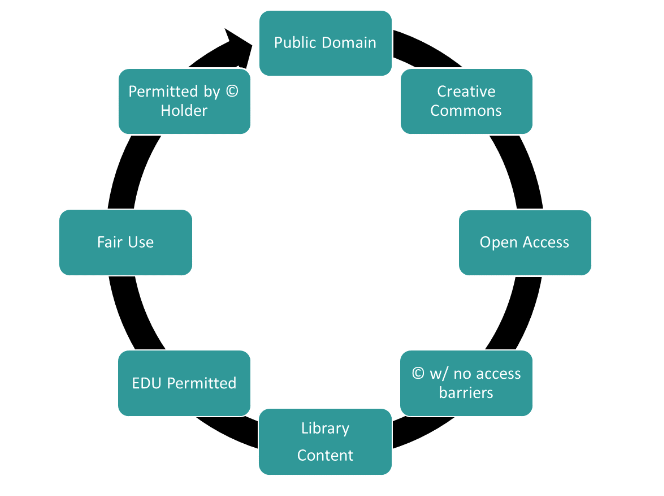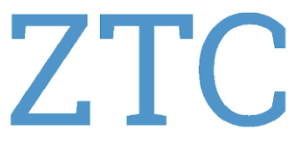2 Understanding Open Educational Resources
“A Quick Overview of Copyright”
By Kathy Essmiller. Licensed under CC-BY. Transcripts.
Learning Objectives
By the end of this chapter, one will be able to :
- Recognize Open Educational Resources (OER) in a Spectrum of Open
- Define what Zero Textbook Cost (ZTC) means
Introduction
Usage rights set Open Educational Resources (OER) apart from traditional materials. Authors of OER can set a variety of different levels of “openness” rights. The Spectrum of Open can help visualize these different levels. It can guide the search for the optimum OER. The first category at the top of the “O” is the public domain. Public Domain materials are the most open content that can be used in an educational setting. Instructors should start their journey to find suitable, quality content there.

The Spectrum of Open. By OPEN FL & Rebel Cummings-Sauls.
Learning Objective Check-In
The Spectrum of Open
The OPEN-FL Community’s Spectrum of Open infographic (shown above) supports an equitable, affordable learning experience. By learning how to incorporate these resources responsibly and effectively, instructors will be ready to reduce cost barriers for students. To compare the types of open content by characteristics, use The Spectrum of Open Table below as a quick reference guide:
| Type | Openly Licensed | Freely Available | Modifiable |
|---|---|---|---|
| No | Yes | Yes | |
| Yes | Yes | Maybe– see specific CC license |
|
| Yes | Yes | Maybe– see license, terms, permissions, or agreements |
|
| Maybe– see license, terms, permissions, or agreements |
Yes | Likely no– see license, terms, permissions, agreements |
|
| Maybe– see license, terms, permissions, or agreements |
For Instructors and Students | Likely no– see license, terms, permissions, agreements |
|
| No | Select Content w/ Public or Student Access | Likely no– see license, terms, permissions, agreements |
|
| No | Select Content w/ Public or Student Access | Likely no– Depends on Fair Use Argument |
|
| Seek permission by copyright holder | Seek permission by copyright holder | Seek permission by copyright holder |
Focus on Open in Florida
In Florida, Statute Section 1004.085 (6)(c) states that:
“the State Board of Education and the Board of Governors shall adopt affordability policies, procedures, and guidelines which the state’s higher education institutions can implement to “minimize the cost of textbooks and instructional materials for students.”
These policies, procedures, and guidelines shall address “the extent to which an open-access book or instructional material is available.” Additionally, there is further support to lower or eliminate the cost of instructional materials through continued and growing legislation. A key piece of this movement is OER as defined by the state statutes (Section 1006.73(4)(a)). This includes support for the Student Open Access Resources (SOAR) repository (discussed later in Searching for OER) and the Zero Textbook Cost (ZTC) indicator, shown below.
Zero Textbook Cost

The materials listed in the table above, used individually or in combination, are all ways to achieve complete cost savings for students. By using open and zero cost materials, a course can be designated as a ZTC course. This indicates to students that there are no costs for access and use of required course materials. FloridaShines, the statewide online course search hub, employs a ZTC course marking and filter. For further information about ZTC courses in Florida, please visit this FAQ page.
Florida’s Zero Textbook Cost Definition
Instructor Voice
“Adopting Open Educational Resources isn’t just about access; it’s about empowering learners with the freedom to explore, the tools to excel, and the knowledge to shape a brighter future without boundaries.”
Douglas Kines, Professor of Biological Sciences
Florida State College at Jacksonville
Conclusion
Understanding the spectrum of open content available is an important piece of the journey towards adopting OER for a class. Familiarity with the terms OER and ZTC help instructors make informed course content choices. Instructors are highly encouraged to adopt OER textbooks and ancillary items for classes. The next chapter will show how to identify OER so instructors feel comfortable adopting it.
Chapter Assessment
Learner Survey
Content in the public domain has fallen out of copyright protection, has been placed in the domain by U.S. law, or was marked as public domain by the content creator.
If you find materials with CC licenses, you are free to use the content as long as you follow the license requirements. You can Search the Commons to find relevant content on a number of search engines and websites.
Open access content is often licensed similarly to Creative Commons content, however there are no set license terms. Each publisher may have different terms and permissions allowed, so content licenses and terms of agreements should be read thoroughly to understand what is permitted.
Content in this area can be open access; however, there may not be a clear, open license. The content should have no access barriers and must be free to use. Any content licenses, statements, and terms of agreements should be read thoroughly to understand what is permitted.
*With this content, it is advised that faculty link out to this content and not embed or re-mix into their course/work.
Works within a library can include content that has fallen into the Public Domain, with Creative Commons Licenses, with Open Licenses, and purchased with education use permissions. Many times you can find these works within your Special and Archives Collections. These types of works are most likely in the spectrum of open and can be used freely in the classroom.
Library licensed works (like subscription E-Resources) are NOT in the open and may only be used according to the library license terms. Please visit with your local librarian to discuss use terms if you have found library content you would like to use in your course.
*With this content, it is advised that faculty link out to this content and not embed or re-mix into their course/work.
Content in this area is most likely okay to use for coursework; however, there is not a clear license. Permissions or terms may even just state "Education Use Permitted." The content should have no access barriers and must be free to use. Content licenses, statements, and terms of agreements should be read thoroughly to understand what is permitted.
*With this content, it is advised that faculty link out to this content and not embed or re-mix into their course/work.
If you are only having students use the materials in the physical class room section or within the LMS you may be able to use exemptions allowed by U.S. law Sections 110(1) or 110(2). However, if you expect students to use the material outside of the active classroom/lecture determine if you have a fair use exemption (Section 107) instead. If you feel the documented evaluation of your use is fair then you may be able to use the content, so long as it is a legal copy. Please note that all exemptions in the law need to be determined each time the content is reviewed or curated. We advise that faculty re-evaluate their exemptions at least once per year. New content is falling into the public domain every year or being created in an openly licensed way everyday.
If necessary, request permission for "unlimited, worldwide" use or purchase a license through a collective rights agency to use the item; it's not very common for an individual faculty member to purchase a license for use of a copyrighted work in the classroom. Faculty members in music, drama, and dance may be familiar with purchasing specific public performance licenses.

